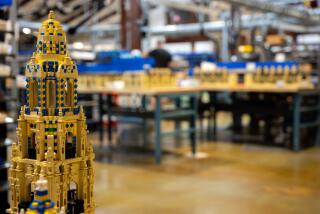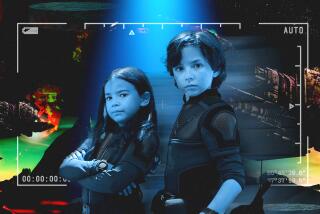Engineering 101
- Share via
In preparing this month’s column, I couldn’t shake off the feeling that I was pulling a Tom Sawyer--that I was tricking the other kids into painting the fence for me.
Seeking young volunteers to test-drive some activity books and do a mini-review, I enticed parents with the words “Make your kid a star!” and hammered respondents with the guilt-inducing phrase “Share some quality time!”
They fell for it. And a column was born. . . .
Jackie Sauceda-Rivera, age 9, offered to take Light Magic: And Other Science Activities About Energy, by Trudy Rising and Peter Williams and illustrated by Jane Kurisu (OWL--Greey de Pencier Books, 56 The Esplanade, Ste. 302, Toronto, Ontario, MSE 1A7/416-971-5275: $9.95) for a whirl.
Jackie, a fourth-grader who has done science projects in school--including the light board mentioned in the book--says “Light Magic” is “a good book for kids learning about science. It teaches how to make light bulbs, water and lots of things with electricity.
“I did two projects from the book. One was to make a light bulb of your own (electric energy) and the other one was how to make a model hovercraft (energy of wind). The hovercraft, using a balloon, margarine lid and a used spool of thread in a pool of water, didn’t work that good but it was a pretty good experiment anyway. It didn’t work because every time it was set on water the air came out and (the craft) only moved a couple of inches.
“The light bulb experiment worked pretty good. I used steel wool, a 6-volt battery, a couple of nails, cork, wire and a bottle for this experiment (plus adult assistance). The light lasted a few seconds. I liked the light bulb experiment because I got to work with electricity.”
Notes Jackie’s mom, Catherine Sauceda: “I found the book to be easy for kids age 8 and up to understand the basics of wind, electric, water, heat energy. The experiments are precise in directions using household items. They are relatively easy and fun with some required adult supervision or assistance.”
There is quite simply no way that I would attempt the project in Build Your Own Empire State Building by Alan Rose (Addison-Wesley: $14.95), even though it comes complete with radio antenna and King Kong. There are too many pieces to cut out, too many pieces to piece together--all of which require to expert handling of scissors and glue, neither of which I mastered in the second grade. So it’s a good thing I found three stouthearted lads to put it together: Steve Margulies, Robert Rostig and Mark Bagwell, all 14 and all used to spending most of their free time in outdoor activities.
The book said it would take 8 hours to put together; that was about right, even with the team approach.
A parent’s (Steve’s dad, Lee) observation: “The boys didn’t like all the cutting out of pieces that had to be done but seemed to enjoy putting them together. Clearly, however, it’s not an experience any of them is looking to repeat soon.”
Robert: “It’s a fun group activity, if you have nothing else to do. But it was frustrating too. The wording of the directions is complicated.”
Mark: “Even if somebody likes to do models, I don’t see why they’d want to do this. People collect cars or airplanes but nobody collects buildings!”
Steve: “I’d rather be skateboarding or bodyboarding than doing something like this. You seriously need a lot of time, because it’s boring work. It’d be perfect if you were grounded.”
More to Read
Sign up for our Book Club newsletter
Get the latest news, events and more from the Los Angeles Times Book Club, and help us get L.A. reading and talking.
You may occasionally receive promotional content from the Los Angeles Times.







